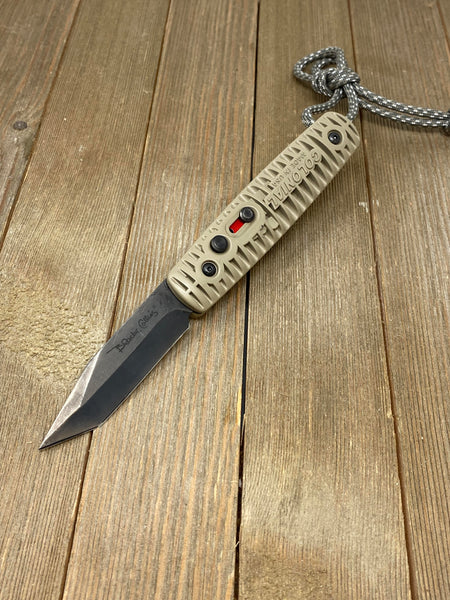

Colonial Knife
Tactical Knife
Colonial Knife Co.® introduces the Tactical Knife Ranger Model 110 Desert Sand with serrated blade and model 111 Non-Serrated

EACH TACTICAL KNIFE GETS HAND INSPECTED
Tactical Knife Ranger Series® With Push Button Blade Deployment one of the special features of the Tactical Knife Ranger series® model 110-the textured non-slip handle resists slippage whether hands are bloody or sweaty. Nonreflective blade, no gloss handle made of Ispolaste® makes the Tactical Ranger Series® indestructible. Desert operation sand color handle, practical, dependable utility, lite-weight system, makes the "Tactical Ranger Series® model 110 knife a favorite of the Contractor."
The names Shur Snap® and Snappy were introduced in 1948. The 4 1/8” fat jack was made with two more tang stampings besides the Shur Snap® mentioned above. Those stamps are “Pronto®” and “Jiffy®” and these knives must have been made in smaller numbers because they are harder to find than the Shur Snaps®. With the addition of these two important variations, there are a total of 10 knives that you’d have to collect to have a good representation of Colonial® switchblade lineup.
The Jumbo Jack® and Stubby knives® all have large round buttons. The fat jack knives®, including the Pronto® and Jiffy®, all have a smaller button with some being flat and some slightly rounded. The buttons on the rest of the "Colonial Shur Snap®" knives help to tell us at what stage of production they were made; early, middle or late. I like to refer to these time differences as generations, four total. Those knives with large brass buttons are the oldest. I call them first generation and they were made in the late 1940s and early ’50s. A large button other than brass would be the second generation for the early 1950s. Small rounded buttons are the third generation and were made in the late 1950s. For the record, the handles on these were NOT made of celluloid as many collectors think. I wanted to be sure so I did the fire test on several handles. Celluloid® is extremely flammable and will ignite immediately upon contact with flame, while plastic will smoke. Also, the odors are very different. The Colonial Handles are some sort of plastic, not celluloid. Interesting, all of the Colonial switchblades® have the brand name over “Colonial” over “PROV USA” stamped on the front tang, but on most of the fishtails®, jacks, and Snappy® all that can be seen or the bottom stamp is “USA”. During the manufacturing, process groves must be cut into the tang of the blade for locking purposes and most the time these grooves must be cut right through the “PROV”, usually obliterating it, though sometimes part of it is still visible.
Printed by permission of Mark Erickson, author of “Antique American Switchblade, Identification Value”
Specifications
- Blade material: Tanto serrated ATS 34.
- Rockwell hardness 58C.
- Blade length: 3".
- Weight: less than 1 0z.
- Indestructible Glass-filled nylon handle.
- Non-slip patented "Tire Traction" texture handle.
- Safety lock prevents accidental opening or closing.
- Push button to deploy the blade locking system for safety
- Mates with M.O.L.L.E. vest.
- Lanyard hole accommodates 550 Para-cord.
- Pocket clip.
- Handle Design: Rhode Island School of Design
- Blade Design: Walter “Blackie” Collins, Cutlery Hall of Fame
- Prototype: Brown University
- Made in the U.S.A.
- lifetime Limited warranty
